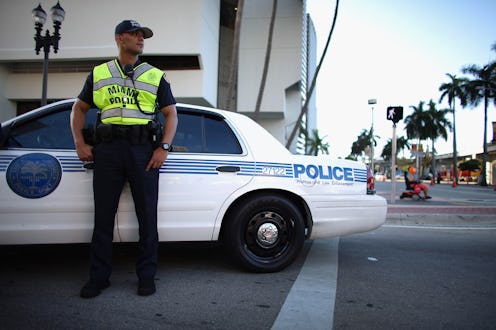News
Students Demand Justice For John Crawford
Wednesday marks the third day of a youth-led sit-in in the Beavercreek, Ohio Police Department. Organized by the Ohio Student Association and Freedom Side, a network of young people are demanding justice for the Aug. 5 shooting of John Crawford III, a 22 year-old black man shot by police while holding an unloaded BB gun in a Walmart aisle. A grand jury declined to charge the officer responsible, although a federal investigation is still ongoing.
Since the shooting of Michael Brown in Ferguson, Miss, the story has become a familiar one: white cops killing young black men in American cities and suburbs. Young people of color are tired of feeling like their lives don’t matter and their deaths can be swept under the rug of department procedure. And in Ohio, students and young people of color are doing something about it: They're protesting, marching, leading workshops, and, now, sitting in the local police department to demand sweeping changes to police procedure and accountability for Crawford’s death.
The officer responsible, Sean Williams, has been placed on administrative desk work until the federal investigation into Crawford's death concludes, but his partner on the scene, Sergeant David Darkow, is already back on duty.
Williams claims that Crawford made an “aggressive” move after he and Sergeant David Darkow commanded him to put the BB gun down, but analysis of the Ohio attorney general office’s investigation into Crawford’s death leaves a troubled record of conflicting witnesses. It's not clear how much time or warning the two officers gave the 22 year-old to put down the toy gun before fatally shooting him. From the store video released recently, it appears very little of either.
Also troubling is the reason that the police officers arrived on the scene with guns drawn in the first place. Ronald Richie placed a call to the 911 dispatch in which he reported Crawford was "pointing" a gun at people, including two children, in the Walmart. He's since walked back some of those assertions, noting that Crawford was "waving it around."
The sit-in demonstrators are seeking justice for Crawford and a sea change in how the town’s police force and prosecutors interact with and perceive its minority residents. To that effect, they are asking for a meeting with the police chief to discuss three demands:
1) that Williams be let go from the police force, or at the very least disarmed;
2) that the department overhaul its police training materials to prevent the aggressive use of deadly force in situations similar to Crawford’s death, and;
3) that the district attorney bring criminal charges against Richie for placing a misleading call to 911.
Although Crawford’s death in Ohio was overshadowed in the media by the protests sweeping Ferguson, young people in Beavercreek and throughout the state began organizing demonstrations calling for justice. On Sept. 22, they led an 11-mile “pilgrimage” from the Wal-Mart where Crawford was shot to the courthouse where the grand jury was listening to testimony.
“We want to really start a conversation around how we fundamentally shift the power dynamics and relationship between law enforcement and community - law enforcement ranging from police officers to sheriff to county prosecutor,” organizer Malaya Davis told Salon on the first day of the sit-in. “An occupation is the way that we’re going to try to force these demands to at least be heard and be taken into consideration.”
For the young people, who have spent the last two nights camped out in sleeping bags inside the Beavercreek Police Station, the questions remain: Would Crawford be alive today if he were white? Would the couple who alerted the police on Crawford at Walmart have made that phone call if they had seen a white man with a BB gun? Would the police have approached Crawford differently or been less quick to use deadly force if he had been white? Would Williams still be an active member of the department?
We may never have good answers. But these actions, from large marches in Ferguson to the sit-in in Beavercreek, begin to shift the narrative around these unacceptable deaths and force us to make a serious project of eliminating racial biases from our police forces and our court systems. By mobilizing in local communities against racial discrimination in law enforcement and the broader criminal justice system, we can work to change the practices, institutions and culture that today gives less weight to black lives than it does to white ones.
Images: Getty Images
